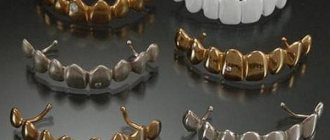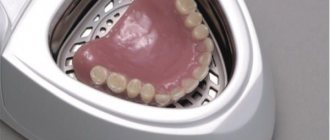4864
Everyone knows that the success of the treatment performed depends on the experience and qualifications of the dentist.
However, not everyone evaluates the quality and composition of the material used in the process of filling a tooth as a fundamental factor in the durability of the filling.
What is a cement filling, and how justified is such a choice? This will be discussed in this article.
Silicate, silicophosphate cements
Materials from this group have been used by dentists for a very long time. Silicone cements have a bright white color, do not hold well, are rough to the touch even after polishing, and when placing such a filling you will feel a sour taste in your mouth. But! “Sourness” also happens when installing an expensive filling, if the doctor used silicate cement for laying under the filling.
Pros: such fillings are low-toxic, which is very good if you are treating a child’s teeth + low price (in some clinics they fill with silicate cement for free!).
Please note: the filling material of this group is prepared by mixing powder and liquid.
Oral health
My friend had a light filling installed, but he says that it is rough to the touch. Although the previous fillings (placed a long time ago) were smooth to the touch. This is fine?
pl2009 [5.3K]
5 years ago
First of all, this is not normal. But everything can be solved quite easily. Your friend should come to the doctor who placed the filling and ask him to polish it. This is not critical. But with the slightest mistake in personal hygiene, a soft coating will appear first, which will very quickly turn into a hard coating, which is much more difficult to clean off. And this is not a matter of filling material. Any filling must be ground and polished. Secondly, I don’t agree that the doctor “forgot” to do this. Unfortunately, in the modern world, not many funds are allocated to ensure the normal functioning of medical personnel. Very often, clinics simply do not have the required tools for grinding and polishing (special burs, brushes, pastes, finishers, polishes). And, if we are talking about free medical care, then there are also time restrictions. So I would not “attack” the doctor so openly (like the previous respondents), but simply recommended that your friend return to the dentist.
the author of the question chose this answer as the best
Askolda [18.3K]
The most annoying thing is that the filling was expensive - $70 for the whole job. But it turns out they did it so badly. It's a shame - 5 years ago
pl2009 [5.3K]
I live in St. Petersburg. And here sometimes the treatment of a small carious cavity costs several times more. So cost is still not the main indicator. I know from my own experience of living in different cities that sometimes dentists do not even know about the existence of certain materials and instruments, due to the constant updating of the product market and the lack of basic interest in new products. After all, sometimes it seems that the best is what has been tested over the years. - 5 years ago
Pro100th [69.5K]
more than a year ago
Dentists usually polish the filling after installation, but in comparison with a real tooth or an old filling, it may still feel rough to the touch with the tongue. This feeling is normal at first, but after a week or two everything will smooth out and it will seem the same to everyone.
So I put a filling four days ago and it seemed to me that it was like sandpaper, but today it has already become smooth to the touch, so it’s worth waiting, the phenomenon is normal.
VeneraD [75.4K]
more than a year ago
Here you need to look at what will happen in a few days. That is, if this roughness bothers a person, causes discomfort, perhaps even scratches the tongue or cheek, of course you need to contact the person who treated it to have it fixed. After all, this is a bad job of a doctor. And in any case, a consultation would not hurt. What if the doctor had a reason to leave the filling in this form, or maybe this was a mistake and then this is a defect.
[user blocked] [143K]
2 years ago
Yes, this is normal, sometimes we, dentists, do not immediately treat fillings with polishers, so as not to once again “rock” the filling or expose it to vibration, and at the next visit, if the filling itself has not “got in”, we polish it. In principle, any filling self-polishes over time, there are simply very “gentle” patients who see deception and a dirty trick in everything. The main thing is that there are no sharp edges on the filling.
Ludwigo [103K]
2 years ago
It is possible that the filling was not polished because in its raw state it is rough due to the uneven alignment of the filling. Maybe the doctor forgot to polish or thought that it was already smooth enough. You can go to the doctor and ask for the filling to be polished; it doesn’t take long to do. If the roughness is not so strong, then over time it will smooth out, you just need to take more careful care of your oral cavity.
Murochka striped [135K]
more than a year ago
Actually, it’s not very good that the filling is rough to the touch and means one thing - the dentist didn’t try hard and was in a hurry to do his job quickly, and probably forgot about polishing the tooth, or maybe he just didn’t want to do it.
In any case, some time will pass and the filling will no longer be so rough.
Inawa [21K]
5 years ago
As if this is not normal. Usually, even when you are in the dentist’s office, the doctor asks whether the filling is in the way or in the way, if it is in the way, then they polish it off there. And now, even more so, the fillings should be better than before.
Nikolay L [9.4K]
5 years ago
Surely the doctor forgot to polish his work (the filling). Well, these are, of course, “seeds”. It happens that during abdominal operations, cotton wool, bandages and even instruments are forgotten. Nowadays it is called the human factor...
Plastic fillings
Dentists of older generations especially like to install them. Younger dentists simply don’t know how to work with plastic fillings anymore! Disadvantages of plastic fillings: such a filling takes a very long time to install, darkens quickly and even wears off. Some doctors very often sin by putting cheap plastic fillings instead of expensive modern ones; such fillings are often used in dental offices at, for example, military units and in public clinics - where free medical care is provided.
How can you tell if you have had a plastic filling? When installing such a seal, you will notice a characteristic plastic smell.
Fillings and inlays
What types of fillings are there? What are tabs? Fillings can be temporary or permanent. Metal, cement, phosphate, composite and several other types. Today we will tell you about the differences between fillings, who gets which fillings, and in what cases the doctor makes inlays. Tooth filling, familiar to everyone since childhood, requires the dentist to carefully perform painstaking and highly professional work. The absolute sterility of instruments and the surgical field, as well as the presence of radiovisiographic control, allows the dentists of our clinic, Dr. Tuktarov, to perform this work with such high quality that its results are given a long-term guarantee!
You can make an appointment with a dentist right now by calling clinic number 8 or leaving your details using the online form.
Amalgam fillings (mercury + metal)
The advantages of amalgam fillings: they last a long time (if the doctor puts it in good faith and no new caries appears nearby, it will last even twenty years!)
Cons: metallic color, which over time can stain the filled tooth itself. And some experts believe that such fillings can harm our health due to mercury particles. Amalgam is placed in secluded places that are not noticeable when you smile. This material is very popular among Asian dentists. If you get an amalgam filling, it will be very difficult not to notice it (see disadvantages).
The main causes of defective fillings:
- An incompletely cleaned carious cavity - in other words, the doctor did not remove all the caries and put a filling on top of it all, as a result, the caries continues to rapidly destroy the tooth, the filling can no longer hold tightly to the walls of the damaged tissue and falls out;
- Due to excessive salivation, most materials used for dental fillings reduce their chances of adhering well to the tooth surface because they are more sensitive to moisture
- Light-curing filling materials harden only under the influence of special dental polymerization lamps, which operate from a special installation or from a battery. So, the doctor needs to carefully monitor the level of charge of the batteries, because otherwise, it will turn out that only the top layer of the filling will harden, while everything inside will remain soft. As a result, such a filling falls out;
- Failure of the doctor to comply with the rules for the formation of a lesion
It often happens that the patient simply wants to save money, so they select cheap filling material that is not durable. Sometimes you just need to change the filling. There are cases when a doctor during an examination suggests including a tooth in the treatment plan, even if it does not bother the patient. This occurs due to the fact that the seal has lost its tightness. A seal is a technically complex product, therefore, like all products, it has its own service life. Over time, any filling can sag. If the seal is lost, the filling is no longer able to protect the tooth from bacteria, and bacteria are the main cause of caries.
Composite fillings (chemically cured composite material)
Consists of inorganic and organic substances. If you are choosing what to fill your back teeth with, choose the latter between light and chemical composite. It is cheaper, and as for the color scheme, no one except you will see such a filling on “distant” teeth.
Installation of a composite filling is done in several stages. If you choose a composite filling, know that the dentist must process and dry the caries hole.
Three stages follow: the enamel is treated with a special acid (if your doctor works without a rubber dam - a special rubber plate that isolates the tooth being treated from the rest, you will feel a sour taste).
After etching with acid, the hole is covered with special glue.
The material for the composite filling is mixed with a plastic spatula on plain paper, combining two special pastes. Once installed, the composite filling must be polished; if this is not done, it will quickly change color.
The cost of installing a composite filling ranges from $15 to $50. It all depends on the greed of your doctor and clinic.
Composite fillings that harden in light
There are special light-hardening fillings for the front teeth and separately for the back ones, and universal ones for all types of teeth.
Modern filling material. It lends itself well to polishing and grinding, is well matched in color, strong and durable. To place a light-composite filling, the dentist will need a special solar lamp (blue light). This filling is placed in layers, each subsequent layer is treated with a helium lamp.
If you notice that your filling was treated with light only once, then it is no longer a composite light filling! Also, the light filling takes a very long time and is carefully polished; the doctor may advise you to come back for re-grinding in six months - do not refuse, this way your filling will retain its color longer.
Price: from 50 to 100 dollars.
Glass ionomer cements
Pros : it contains fluoride, which protects our teeth from relapse of caries; there is no need to install insulating and therapeutic linings.
Cons: wears off, the color of the filling differs from the color of the tooth.
Glass ionomer cements are often combined with a light filling. Dentists call this mixture the “sandwich technique.”
Prices: from 20 to 50 dollars.
We hope our tips will help you control the quality of your dentist’s work and avoid being scammed.
It is worth mentioning that you can only find out which filling was installed after the fact from another specialist. Another dentist, uninterested in your ignorance, will be able to tell you for which filling you paid for a light filling, a chemical composite, or whether you received the cheapest filling.
If this material caught your eye before going to the dentist, familiarize yourself with the features of placing different types of fillings, and sitting in a chair, noting for yourself the sequence of the dentist’s work, you will be able to determine what kind of filling he is trying to put on you, and, if necessary, in time stop!
Lina Talina
notabene.info
Still, there are lucky people who rarely hear the sound of a drill. Well, very rarely. There are those who almost register at the dentist's office. However, be that as it may: sooner or later, everyone has to have their teeth treated.
So, the exciting process - anesthesia, drilling (cleaning the carious cavity), processing it and placing a filling - is over. And you can chew, and the tooth is as good as new. We take a deep breath, smile at the doctor, pay at the reception desk or at the administrator’s cash desk.
You seem to be happy with everything. Like? Or happy! And what criteria, exactly, are used to evaluate whether a new filling is good or... not good at all? To understand, let's understand. An assistant at the Department of Orthopedic Dentistry, a dentist at the Belarusian Medical Academy of Postgraduate Education, Yuri Aurelovich KOSTETSKY, will help with this
Pay attention to:
- 1. First, check whether the filling is bothering you. In no case should it interfere with the closure of antagonist teeth. There simply shouldn’t be any noticeable discomfort.
- 2. Now look in the mirror to evaluate the color rendition of the filling material: the filling should not lie on the tooth with a white, yellow or amber-colored spot. Ideally, if the doctor used high-quality material (for example, a light-polymer composite, ormokers or hybrids - read more about this here - you should not see the filling in principle. With good aesthetics, it should not be in contrast to the color scheme of natural teeth.
- 3. A high-quality filling is well polished, and when you touch it with your tongue, you should not feel the rough surface.
- 4. You just like her visually.
- 5. After placing the filling, the tooth should not hurt. No comments needed.
- 6. Finally, a long-term point that can be assessed not now, but after a while - the filling should last a long time! More about this below.
You can’t chew with a “flat”!
- Now let's take a closer look at the details. If the doctor placed a filling on the chewing surface, it should not look like a “smooth lake.” After all, the natural anatomical shape of a chewing tooth has tubercles and fissures (“elevations” and “cavities”).
It is the tubercles that help chew and grind food. That is why it is so important to restore them. Otherwise, the efficiency of the tooth is lost: the food is no longer crushed so thoroughly, and the digestion process is disrupted.
Therefore, a good doctor is obliged to shape the chewing surface when placing a filling in order to restore harmonious occlusion - the closure of the upper and lower teeth.
"Closer and Closer"
— The filling that the doctor places on the side surface of the tooth (or teeth) must have a dense point of contact.
Let me explain. Teeth adjacent to each other, touching, form an important zone. In dentistry this is called a contact point. It protects the interdental space and gums from food ingress, trauma to the mucous membrane and the formation of caries.
And if during treatment the contact point is not formed dense and pointed, then food debris will begin to accumulate in the interdental space and cause inflammation of the gums.
Caries one and two
— The tooth is healed, but the filling has overhanging edges. What it is? Due to careless work, the filling material leaked onto the gums. Why is that bad?
Because small food particles will accumulate under the overhanging edges. They cannot be cleaned with either a brush or dental floss. And all this threatens with secondary caries under the filling.
They installed it and... “fell off”
— How long will the filling last without unexpectedly “popping out” while chewing gum, candy, or barbecue? This depends on many factors. The qualifications of the dentist, adherence to treatment technology and, of course, the quality of filling materials are important.
However, that's not all! The condition of the tooth is important. More precisely, the degree of mineralization of enamel, which is disrupted by general diseases, poor oral hygiene, stressful conditions... This disrupts the mineralization of dental tissues. As a result, the fillings hold up worse.
What can you recommend? The remineralization procedure is the strengthening of tooth enamel with restorative mineral components.
Loving the doctor without memory!
— If the filling falls out after 2 years, this is regarded as insufficient quality treatment. 5-6 years is the minimum that a good quality “dental patch” should last.
Can we expect that it will become a “long-liver” and will serve properly for 15-25 years? It is possible, but it depends on many conditions: its type and color, the condition of the hard tissues of the tooth under the filling, the chewing and functional efficiency of the restoration.
Dentists need to work with this long-term effect. Then the patient will love his doctor, as they say, without memory.
www.interfax.by
What fillings are there by type of use?
Temporary fillings
Temporary fillings are designed to be removed later and replaced with permanent ones. Most often they are used for therapeutic and diagnostic purposes. Let's say the doctor is not completely sure whether the nerve is damaged or not. To do this, a temporary filling is placed; if the tooth is sick, then the nerve must be removed.
Temporary fillings are also called medicinal fillings, because most often they hide various medications, which will then need to be removed. Those. a temporary filling is not the one that fell out on the 3rd day after visiting the doctor, but a filling that the doctor removed himself without much difficulty after a certain period of time.
Permanent fillings
Permanent fillings are fillings that should last for years and decades. Those. The filling that fell out a month later does not fit any classification and was placed either in violation of the technology or without taking into account mechanical loads (perhaps a crown was needed).
Tooth filling - how it happens and how it should be. Is a dental filling a panacea for caries or not?
What do they most often ask a dental clinic administrator over the phone?
How much does it cost to fill a tooth? If the price suits you, then sign up. If not, then they call further to other oases of dentists. With such a call, it is not taken into account what kind of seal we are talking about, what material it will be made of, the main thing is how this same seal will be placed. Let's try to figure it out and explain why. If you are interested, read it for your health.
Dental filling is also called tooth restoration, tooth extension. How should tooth filling be done? We will not consider the option of express dental filling in 20-30 minutes and do not recommend it to you. This method of dental treatment takes at least 40-60 minutes. And the maximum can reach 2-2.5 hours.
First, the dentist administers anesthesia. Then it removes all carious, diseased tissues of the tooth being restored. If you cheat at this stage of tooth treatment and leave the beginnings of caries, then in six months to a year the tooth filling will no longer meet the gold standard of quality or will simply fall out. Under it, caries will continue its dark work, which will end with either pulpitis or loss of the filling.
Previously, the dentist decided on the complete removal of caries easily - by eye. Now dentists use special preparations, so-called caries detectors. It is applied to the tooth being restored. If its color is pleasant pink, then everything is OK. If the color is different, then caries is still nesting in this place. The dentist sees exactly where additional preparation of the tooth being restored should be done.
Why such trouble? Is it possible to remove obviously more dental tissue before filling a tooth? Yes. This is exactly how it was once done, called “preventative expansion.” There is a common opinion among dentists that the more remains of the tooth, the better. We adhere to this when filling teeth. Miracle bors help us with this. They selectively process the tooth - they easily remove caries and have difficulty preparing healthy enamel and dentin.
The tooth has been treated, can I get the long-awaited dental filling? No. If, of course, we want to get a decent result - a tooth filling for a long time, almost forever. It is necessary not only to remove all caries, but also to properly restore the tooth.
Teeth filling occurs in the mouth, where there is a lot of moisture. And tooth filling, as you know, does not like water during filling. To do this, when filling teeth, the dentist isolates it from moisture and saliva using numerous devices: rubber dam, retraction threads, dental wedges. A rubber dam is a rubber scarf that separates the future tooth filling from the rest of the teeth and saliva. It can also be liquid - it is applied around the tooth filling on the gum and cured with a special lamp. A retraction thread is inserted between the gum and the tooth being filled to prevent moisture from the gum from getting onto the tooth filling.
When it is necessary to restore the side surface, the dentist has a very difficult time - the tooth filling needs to repeat its original shape and fit tightly to the adjacent tooth.
The tooth filling must accurately follow the contours of the tooth. Otherwise, the filling of the tooth does not touch the neighboring one - food will get in and injure the gums. Or - food won’t get stuck easily, but once it gets in, it will be impossible to get it out. Even with a kilogram of chewing gum. Such a tooth filling will constantly injure the gums, chronic inflammation will appear, the gums will turn red and begin to bleed. So it’s not far from periodontitis.
How can a dentist work in tight spaces between teeth? Put in excess material and then remove the excess? Only Tseriteley can do this, and then only with sculptures. Therefore, a retraction thread is placed that moves the gum back so as not to pinch it and prevents moisture from entering the working field. Then a suitable matrix is installed, repeating the shape of the tooth being restored and creating the shape of the future tooth filling. One or more wedges are selected to size, holding the matrix in place so that the filling material does not leak between it and the tooth being filled. There are whole systems of matrices and holding devices that we use. We will not describe them separately - their principles and tasks are similar.
Only now can you begin to directly create a tooth filling. At the same time, modern light fillings require careful adherence to the technology of their application, exposure, degree of drying, etc. We will describe only the stages, without explaining them: etching, rinsing with distilled water, drying (without overdrying), applying adhesive, drying, polymerization with a dental lamp. And only now is it the turn for the filling material, which is introduced not in one portion, but in parts, each of which is separately processed with a lamp.
Now about the dental fraternity. Tooth to tooth brother, comrade and relative at last. Fraternization of teeth is impossible in nature - they don’t have hands and that’s it! Therefore, when a dentist puts a filling on the side surface, he shouldn’t play havoc with the teeth; he shouldn’t put one filling on two teeth. And at the same time, fill the tooth tightly to the neighboring one (it’s good if there is one), restore the contact surface so that the teeth stand as they should, shoulder to shoulder, and not in an embrace.
Further. All scaffolding and formwork from matrices and wedges of their counterparts are removed. The filling is adjusted to the bite, processed with special burs - polishing only it and not damaging the tooth enamel in any way. Then it is polished with special polishing pastes, discs, rubber bands and other tricky things. Why polish like that? So that the surface of the filling is like enamel - smooth and shiny, without roughness. Is it necessary to polish the side surface of the filling? - You ask. Certainly. Otherwise, the roughness existing there will lead to an inevitable accumulation of plaque... and then off we go again. The side surfaces of the tooth filling are polished with strips - such as fine sandpaper on a thin and narrow strip. As usual, it’s also different. Polishing should end with the finest of them, so that it is very, very smooth. Could such polishing create a gap between the tooth filling and the adjacent tooth? Yes, and this will lead to food and plaque getting in there... To prevent this gap from appearing, dentists, when installing the wedges described above, slightly wedged the space between two teeth, and when polishing with strips, they removed the excess.
Tired? We are also tired of describing it. What about during treatment? That’s why dentists call this kind of work not just tooth filling, but tooth restoration, that is, restoration. How can all this be done in 20 minutes? Answer: “Impossible.” That’s why treatment of one tooth takes an hour, or even more.
When restoring a tooth, the dentist must, and simply must, well recreate not only the area of the tooth near the gum, but also the chewing surface, so that the patient can fully chew culinary delights without problems. That is, the chewing surface of the tooth filling should not be as smooth as an airfield, but should have bumps and pits. The science of such bumps is called gnathology and is designed to confuse you even more, dear reader, because the creation of these bumps is not only extremely important, but also extremely complex. This is done completely individually and depends largely on the neighboring teeth, antagonists, bite, joint, etc. etc... But, please, do not confuse bumps with roughness. A good tooth filling is polished so that it is smooth, like ... (your comparison), or rather many times smoother, so that food residues do not settle on it, do not change it, do not paint it, my dear, in all the colors of the rainbow.
What kind of tooth filling should I put? A rhetorical question. It depends on the degree of destruction of the tooth itself, the location of the defect, and the need for cosmetics.
Is a dental filling a panacea for caries? It depends on two people - the dentist and the patient. If the dentist has removed all carious tooth tissue, provided dry conditions for creating a tooth filling, and observed all the smallest nuances of tooth restoration technology, then he has done well. And the tooth filling will cost wow.
But this also requires the efforts of the patient himself. Which? Simple and banal teeth cleaning. As we know, all diseases come from nerves, some from love, and dental diseases from plaque... That’s where it all begins. The junction of the filling and the tooth is the Achilles heel of the entire restored tooth. She needs to be protected and cherished. If plaque is constantly present in this area, then caries will appear over time... Which is not what we want for you. Therefore, you need to brush your teeth. How - see here (link will be ready later). And ask your hygienist.
What to do if the tooth filling is undermined by caries? It's simple. Do you visit your dentist for preventive examinations? By the way, such examinations are free with us. The most important thing is to notice changes in the tooth filling in time. Then the dentist processes the tooth filling. And restores the tooth with a small filling. Without touching the main filling of the tooth. Simple, cheap and cheerful. But what happens if you don’t notice such a change? In this case, a complication is possible - inflammation of the nerve, then it will have to be depulped and the tooth filling completely replaced. Even if the tooth remains alive, replacing the tooth filling is inevitable.
Conclusion: it’s up to you to decide how much dental filling you need. If you want to preserve the results of tooth restoration for a long time, brush your teeth and periodically go for a medical examination.
Summary.
www.ardenta.ru
Immediately after a filling, the cause of discomfort in the mouth may be the lack of treatment before the filling is placed, and having a healthy tooth can create an unusual feeling of something new.
discomfort conditions of a filled tooth are a reason to urgently consult a doctor
- Foreign body sensation requires diagnosis to determine the origin of the discomfort. If you ignore such a symptom, there is a possibility of developing more complex inflammatory processes.
- A feeling of roughness and scratching indicates insufficient polishing of the filling. The defect is quickly eliminated with a second visit to the doctor and additional polishing to a comfortable state.
- An incorrect bite indicates an incorrect formation of the shape of the filling, which is measured in fractions of millimeters. The reason for this situation is the fact that anesthesia, which continues for some time after the filling procedure, does not make it possible to fully feel the shape of the tooth. Numbness of the jaw under the influence of anesthetics makes it difficult to report the presence of discomfort in the dentist’s office immediately after the filling is installed. The shape of the filling is quickly corrected by filing during a second visit to the doctor.
- A tightening tension in the jaw, a feeling of pressure inside the filled tooth, and discomfort when closing the teeth are created by an oversized filling. This is caused by increased pressure on the tooth walls and nerve endings. Possible consequences range from microdestruction of the dental wall to bacterial inflammation, from malocclusion to diseases of the temporomandibular joint.
- An incorrectly shaped filling can also create additional trauma to the oral mucosa when wearing orthopedic structures.
- Some time after the filling is installed, an increased reaction to irritants even without them (sour, cold, etc.) goes away with the correct selection of paste and other means. A sensitive reaction can be triggered by overdrying of the dentin during filling or loss of tightness of the filling material. To get rid of unpleasant sensations, the intervention of a doctor is necessary.
- Uncomfortable sensations during eating and the entry of food particles into the interdental spaces require the restoration of the interdental contact point, which determines the anatomical correspondence of the filled tooth with the rest of the teeth.
- An allergy to the components of the filling material is sometimes accompanied by bitterness in the mouth, pain, and skin reactions: itching, rash. In such a situation, the filling is replaced with a material that does not cause an individual reaction.
Dental specialists at Die Hard will individually consider the causes of discomfort after installing a filling and eliminate them, providing you with the comfort of healthy teeth. Dentistry in Moscow will cope with even the most complex inconveniences that appear after filling.
oreh-dent.ru
Why can caries form under a filling?
Caries under a filling develops for various reasons:
- Incomplete removal of damaged tooth tissue. The dentist must take a responsible approach to caries treatment. A small amount of bacteria is enough to destroy a tooth from the inside. That is why, in the treatment of caries, a drill is used to drill out the affected tissue.
- Shrinkage of the filling. After hardening, the filling material may shrink in size, a process called shrinkage. The problem is especially relevant for light fillings, since violation of the filling technique inevitably leads to shrinkage. Also, the long service life of the filling (from 5 years) causes a decrease in its size.
- Loose joint between enamel and filling. If there is a gap between the composite and the tooth, bacteria and food particles can become trapped. Since it is often difficult to remove them from there, the process of decay begins, leading to caries.
- Abrasion of the seal. Incorrect installation of the filling, problems with bite, exceeding the service life, negligent attitude of the patient - all this leads to the fact that the filling material wears off. Negligence should be understood as non-compliance with hygiene rules, frequent eating of solid foods, etc.
READ ALSO: What does a light seal look like?
It is unlikely that it will be possible to understand why recurrent caries occurred. Usually it is caused by several reasons.
How to install a filling
Filling is a rather complicated process, because it is very important to return the tooth to its original appearance and place the filling correctly.
The process is carried out in several stages:
- To begin with, all dark and softened dentin is removed from the carious cavity. It is also necessary to avoid the formation of too thin tooth walls.
- Next, the surface is washed and disinfected with antiseptics.
- The cavity is dried.
- Deep and medium caries require the application of a therapeutic pad with calcium. This helps relieve inflammation and also has a good antimicrobial effect.
- Next, an insulating gasket is applied. This allows you to protect the tooth from the toxic effects of materials.
- Next, the filling itself is placed on the tooth. The method of its installation depends on the type of materials (silicate, composite, antimagnetic filling, etc.).
- At the end, sharpening is performed to get rid of discomfort when closing the jaws. Next, the filling is ground and polished. It is important that it matches the anatomical shape of the tooth (has cusps, grooves).
After all stages are carried out correctly, you can hope to restore the functionality of the tooth and its attractive appearance.
Treatment
Treatment methods for secondary caries depend on the volume of affected tissue. If secondary caries has not had time to fully develop, then the old filling is simply removed. The cavity is thoroughly disinfected, treated with medication and refilled. In some cases, only part of the filling material where the defect is observed is removed.
If the tooth is practically rotting, filling will not help. Either special inlays or prostheses are used. In advanced cases, the tooth is removed.
Removing old filling and re-filling
Re-filling is a procedure that requires special attention. In case of an error, there is a high probability of relapse; the tooth is unlikely to be cured again. The process takes place in several stages:
- removing old filling material with a drill,
- removal of dead and diseased areas of dental tissue and remaining composite,
- cleaning tooth tissues,
- treatment of the cavity with antiseptic agents,
- installation of an insulating gasket,
- tooth filling,
- grinding the filling under the bite, eliminating filling defects.
Photopolymer composites are often used as filling materials, characterized by a long service life and high wear resistance. The dentist stains the carious areas with a special product that shows whether damaged tissue remains.
The doctor’s task is to install a high-quality filling without defects or gaps between the material and the tooth. The patient can help the dentist without interfering with his work:
- keeping your mouth wide open
- without moving your tongue,
- without swallowing saliva,
- without talking,
- without making unnecessary movements.
Adhesive restoration
Sometimes, due to extensive damage to a tooth by secondary caries, a crown is installed on it after the defect is eliminated with a filling. Adhesive restoration is an alternative method for treating recurrent caries. Its advantage is its minimal impact on the enamel and preservation of tooth integrity.
The procedure is carried out in one stage; the tooth affected by secondary caries is treated with an adhesive polymer. It restores damaged enamel and reduces its sensitivity.
Crowns and inlays
The dentist installs a crown if the use of other treatment methods is inappropriate, but if the tooth root is damaged by secondary caries, prosthetics are impossible. In this case, removal is indicated.
Crowns are made from various materials:
- medical steel alloys have an unaesthetic appearance, therefore they are used for the treatment of chewing teeth,
- metal ceramics are durable and aesthetic,
- ceramics have maximum similarity to the natural color of teeth, but are not able to cope with high loads.
The crown is made from a custom impression and is first placed temporarily. The reaction of the tooth is studied - if it is positive, the prosthesis is fixed on a permanent basis.
Microprosthetics – installation of special prosthetic inlays based on an impression. They are similar to teeth in color and shape, and are also tightly fixed without causing discomfort.
Types of fillings (difference from each other)
Any installed seal must meet many requirements, first of all, safety for humans, invisibility, durability and strength.
Color and properties depend on the material from which it is made. Often these are ceramics, plastic, amalgam, or special cements.
Among the wide variety of fillings, several main groups can be distinguished:
The first group is silicate and silicophosphate cements (“Sicilin”, “Fritex”). Used in dentistry for a long time.
The disadvantages are: not aesthetically pleasing, the ability to hold on only if the entire carious cavity is ideal.
They also cannot be polished, are rough and cause an unpleasant acidic taste in the mouth. Nevertheless, they are characterized by low toxicity and are often used in pediatric dentistry.
The second group is plastic fillings (for example, Acrylic Oxide). They are well known among senior dentists. And young specialists rarely know how to use this material.
The disadvantages of such fillings are the laboriousness of the treatment process and serious shrinkage during hardening. Over time, plastic fillings darken and wear off quite quickly. There is also a plastic smell in the mouth.
The third group is amalgam. It is an alloy of mercury and metal. The main positive feature is durability.
The main disadvantage is the metallic color of the filling, which over time stains the tooth. Popular in dentistry on the Asian continent.
The fourth group is composite. The advantage is low cost. The material is not very aesthetic, but is good for treating back teeth. Prices are quite different, depending on the country of production.
The fifth group is light-curing fillings. Microphiles are used to fill front teeth, and macrophiles are used for back teeth. There are also hybrids that can be used for any purpose.
This is the most modern material. Characterized by strength, aesthetics and durability. A blue-emitting device is used for hardening. Light filling is ideal for aesthetic restorative procedures.
The sixth group is glass ionomer cements. There are self- and light-hardening types. The advantages are the presence of fluoride in the composition, which reduces the risk of caries, as well as binding to the tooth, preventing the appearance of microcracks.
The disadvantages are the low level of strength and lack of aesthetics.
Treatment of wedge-shaped defect
Let's first consider traditional methods of treatment.
Applications of various preparations: varnishes, ointments, remineralizing solutions, etc.
The main advantage of this method is compliance with the most important Hippocratic principle: “Do no harm.” Indeed, this method of treatment will not harm the teeth. And it can bring benefits in the form of getting rid of hypersensitivity. True, after 10-15 visits, a single application is only enough for a few hours/minutes. It is impossible to eliminate the resulting defect by application, but you can get rid of the pain for some time.
Using toothpastes that reduce sensitivity (desensitivity)
This method includes all the advantages of the previous one, plus it has one more advantage - low cost. One tube of paste costs much less than 10-15 visits to the dentist, but the effect is approximately the same. Just as in the first case, it will not be possible to eliminate the defect itself and its further development. The maximum that can be achieved is the disappearance of pain in the necks of the teeth.
Filling with various materials
Glass ionomer, compomer, flowable or universal composites.
The most common treatment option for wedge-shaped defects. There are even more advantages: the pain disappears immediately after the first visit, and most importantly, the defect itself is eliminated and a fairly good aesthetic result is achieved. The trouble is that the cause of the disease cannot be eliminated by the most modern, best, most durable, most expensive filling.
This means that the mechanical load on the neck of the tooth will continue its negative impact. As a result, the fillings either fall out entirely, or (most often) remain in place, but at the same time they tear off one of their surfaces from the tooth, forming a gap into which food debris and bacteria become clogged. The photo clearly shows a dark strip between one surface of the filling and the tooth, the so-called “mourning border”.
It is undesirable to leave everything as it is - in addition to the progression of the wedge-shaped defect, you can now also get caries in this place. The old filling is removed, a new one is placed, and everything begins for the second round.
Installation of veneers
A veneer here means a ceramic veneer that covers the entire anterior and chewing (cutting edge of the front teeth) surfaces of the tooth.
This method is even better than the previous ones. In addition to superior aesthetics, it is sometimes possible to eliminate the cause (and therefore prevent recurrence of the disease for some teeth). But this will call into question the strength of the veneer itself. The maximum load will fall on it, and this structure is fragile to a certain extent. It may not be able to withstand the efforts from which the tooth’s own enamel has even been lost.
Therefore, veneers for wedge-shaped defects are most suitable for wealthy housewives and other citizens who have enough time and finances to regularly replace those that fail with new ones.
Manufacturing of artificial crowns (metal-ceramic or all-ceramic)
A radical, but very effective solution to the problem. Provided that the edge of the crown covers the wedge-shaped defect with a margin. But often this very reserve is not there - the defect is already located at the level of the gum, and grinding a tooth below the level of attachment of the gingival margin for a crown is strictly contraindicated. In addition, while protecting some teeth, crowns can put others at risk.
It turns out that even such generally reliable structures as crowns do not always solve the issue completely. A wedge-shaped defect can continue its destructive development on a tooth covered with an artificial crown and on neighboring teeth.
All of the above treatment options have one common drawback - they do not normalize the bite or eliminate the cause of the disease. Therefore, even if some of you, dear ladies and gentlemen, were helped by just toothpaste or a banal filling that has served faithfully for several decades, then consider yourself lucky. “Lucky” is such a capacious term in medicine, meaning that, despite inadequate treatment, a change in the living conditions of the body led to spontaneous self-healing.
In this case, destruction, mobility, installation of a large composite restoration or removal of the antagonist tooth will lead to the elimination of the etiological factor of the wedge-shaped defect. But a patient, much less a doctor, should hardly count on such dubious “luck.”
One of the most important tenets of medicine is: “Treatment must be predictable.” That is, to give a positive result in the maximum possible number of patients. In our opinion, it is not possible for a doctor who considers a wedge-shaped defect to be a “disease of unknown etiology” or who knows the cause, but for some reason ignores it, to achieve such a result.
Temporary fillings and their purpose
In addition to the permanent one, there is a temporary filling. It is intended for the treatment of deep caries. It is made from special grades of cement, dentin and Vinoxol.
Such fillings have become widely used to seal medications embedded in the hard tissues of the tooth. Provides tight closure for a short period of time.
The cost is not very high, they are easy to use, and have good adhesion to the tooth. They are also fairly easy to remove once cured.
You should not assume that a temporary filling is the end of treatment. This is just the first stage. Periodic discomfort after the installation of such fillings is considered normal. But it is important to replace such a filling with a full one in time.
A good filling should:
- Have a proper chewing surface.
It cannot be perfectly smooth, because it is the bumps that allow you to chew food. Therefore, it is important to give the tooth a natural shape.
- Have a good point of contact.
The contact point is the area between the teeth where they contact. The accumulation of food in this area can cause caries. Therefore, the contact point must be precise and dense.
- Do not have overhanging edges or voids.
Food debris that can accumulate under overhanging edges or in voids will inevitably lead to secondary caries.
- Have filled microvoids.
Microvoids lead to rapid tooth wear, so it is important to apply a special composite after polishing.
Causes
Deep caries under filling
Most often, the secondary development of dental caries is observed after poor-quality treatment at the first visit to the dentist. The affected area could have been cleaned in bad faith, or the technician may have violated the filling technology.
In this case, the remains of caries continue to actively develop under the filling material, destroying bone tissue. Other reasons can also provoke the disease:
- poor preparation of the tooth surface for the installation of a filling, as a result of which the cement begins to crumble along the edges, creating microcracks;
- shrinkage of fillings made of light-polymer materials (the larger the parameters of the insert, the higher the risk of shrinkage of the material during the polymerization process);
- poor connection between filling and tooth enamel.
In addition, there are additional risk factors, which include poor oral hygiene or the presence of malocclusion. In the process of closing the upper and lower jaws, the load on certain teeth increases, which is fraught with the formation of cracks and chips. Bacteria settle in microcracks and quickly develop, which leads to the development of caries.
Damage to fillings or tooth enamel can be caused by hard or tough food or exposure to low or high temperatures. Therefore, it is necessary to develop a diet taking into account the characteristics of the teeth.
Pain after installing a filling (why it hurts, how to eliminate it)
Sometimes pain and discomfort may appear after treatment. The filling often hurts in the first couple of hours after visiting the dentist.
This is considered normal. But if the treated tooth hurts under the filling and continues to bother you for several weeks, you need to consult a doctor.
The pain may be caused by newly formed caries. In this case, new treatment is necessary.
Pulpitis, an inflammation of the nerve, can also cause pain. In such a situation, the carious cavity is cleaned, the damaged pulp is removed, and the dental canal is filled.
Cyst formation is also a common cause of pain. This requires urgent medical intervention. The doctor cuts the gum and removes the cyst.
A common cause of toothache is an allergy to the material. In this case, an alternative type or manufacturer is used.
If it is not possible to immediately consult a dentist, you can reduce pain in the following ways:
- If the pain is severe, you should take a pain reliever and rinse your mouth with a solution of soda and iodine.
- If you experience pain after installing a temporary filling, you can remove it and get the medicine. But it is very important to visit the dental office as soon as possible after this.
- It is always important to brush your teeth regularly and use special rinses. It is important to remember that heating a tooth that hurts is strictly prohibited, because this leads to an even greater development of the inflammatory process.
Thus, it should be noted that there is a wide variety of filling materials available today. But it is very important to take care of your own teeth, because prevention is always easier than treatment.
vseozdorove.ru
Fillings permanent and temporary
Depending on the purpose and duration of service, there are two types of fillings:
- temporary;
- permanent.
Why are temporary fillings needed?
The specialist decides to install them in cases of severe carious lesions and destruction of tooth tissue, when it is not immediately clear whether the destructive process has affected the dental nerve. If, after installing a temporary sample, the tooth begins to hurt, then the pulp is removed, the canals are cleaned and a permanent structure is installed. A substance that kills the nerve is also placed under a temporary structure.
This type of dental product is installed for preventive purposes in order to preserve the integrity of an already treated tooth before installing a composite inlay.
The service life of a temporary filling is from one to two days to one year. It all depends on the quality of the material and the purpose of the structure. The temporary filling wears off quickly.
A temporary filling is installed for a while
Purpose of a permanent filling
Permanent fillings are made from durable materials so that they perform their role for as long as possible. According to the rules, the design should fit tightly to the tooth tissue and fit well with the bite. Today, aesthetics plays an important role.
An ideal filling should be invisible and match the color of the tooth enamel.











